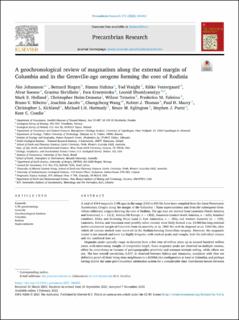| dc.description.abstract | A total of 4344 magmatic U-Pb ages in the range 2300 to 800 Ma have been compiled from the Great Proterozoic Accretionary Orogen along the margin of the Columbia / Nuna supercontinent and from the subsequent Grenvillian collisional orogens forming the core of Rodinia. The age data are derived from Laurentia (North America and Greenland, n = 1212), Baltica (NE Europe, n = 1922), Amazonia (central South America, n = 625), Kalahari (southern Africa and Dronning Maud Land in East Antarctica, n = 386), and western Australia (n = 199). Laurentia, Baltica, and Amazonia (and possibly other cratons) most likely formed a ca. 10 000-km-long external active continental margin of Columbia from its assembly at ca. 1800 Ma until its dispersal at ca. 1260 Ma, after which all cratons studied were involved in the Rodinia-forming Grenvillian orogeny. However, the magmatic record is not smooth and even but highly irregular, with marked peaks and troughs, both for individual cratons and the combined data set.
Magmatic peaks typically range in duration from a few tens of million years up to around hundred million years, with intervening troughs of comparable length. Some magmatic peaks are observed on multiple cratons, either by coincidence or because of paleogeographic proximity and common tectonic setting, while others are not. The best overall correlation, 0.617, is observed between Baltica and Amazonia, consistent with (but not definitive proof of) their being close neighbours in a SAMBA-like configuration at least in Columbia, and perhaps having shared the same peri-Columbian subduction system for a considerable time. Correlation factors between Laurentia and Baltica, or Laurentia and Amazonia, are below 0.14. Comparison between the Grenville Province in northeastern Laurentia and the Sveconorwegian Province in southwestern Fennoscandia (Baltica) shows some striking similarities, especially in the Mesoproterozoic, but also exhibits differences in the timing of events, especially during the final Grenville-Sveconorwegian collision, when the Sveconorwegian evolution seems to lag behind by some tens of million years. Between the other cratons, the evolution before and during the final Grenvillian collision is also largely diachronous. After 900 Ma, magmatic activity had ceased in all areas investigated, attesting to the position of most of them within the stable interior of Rodinia. | en_US |

